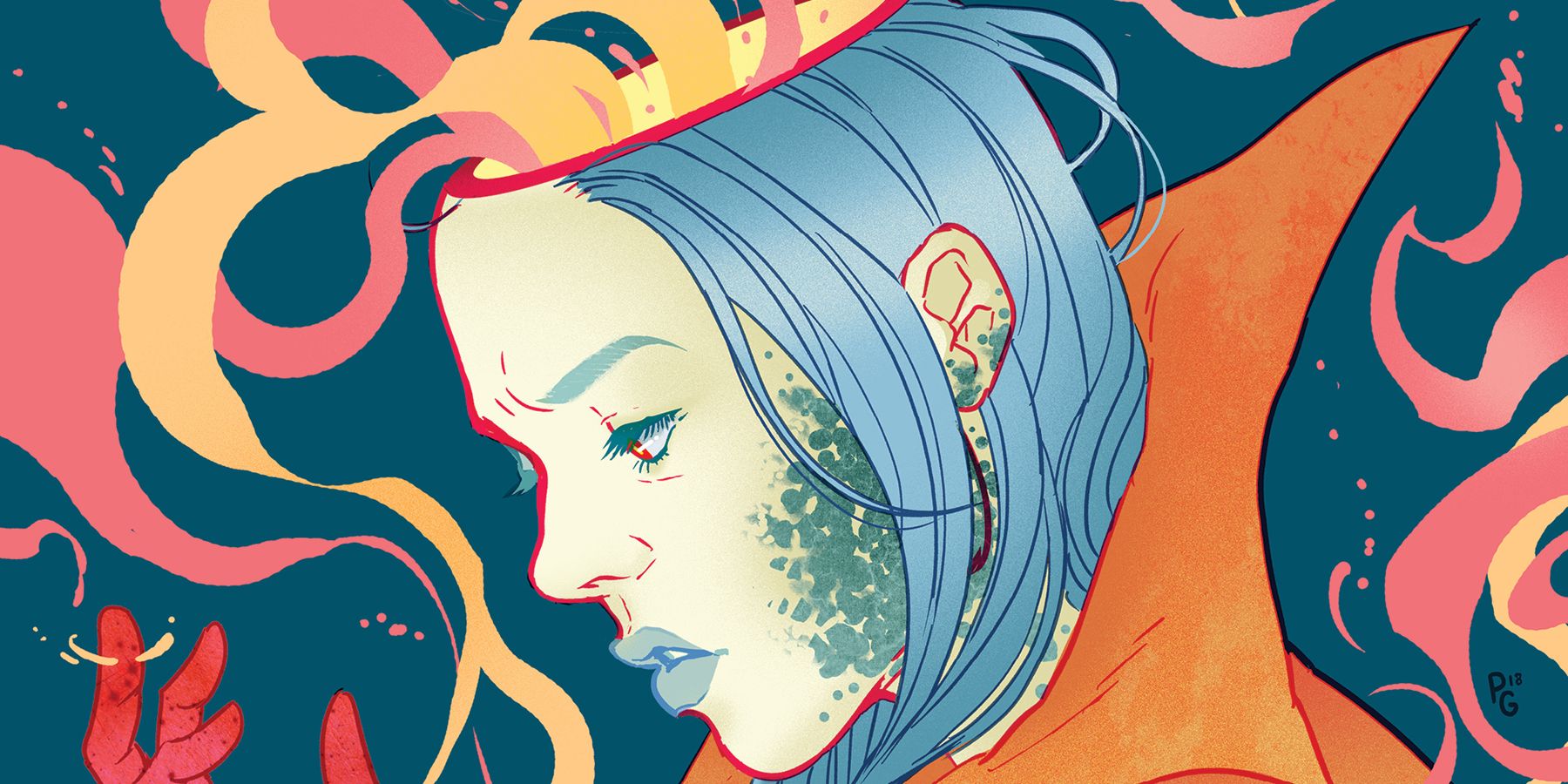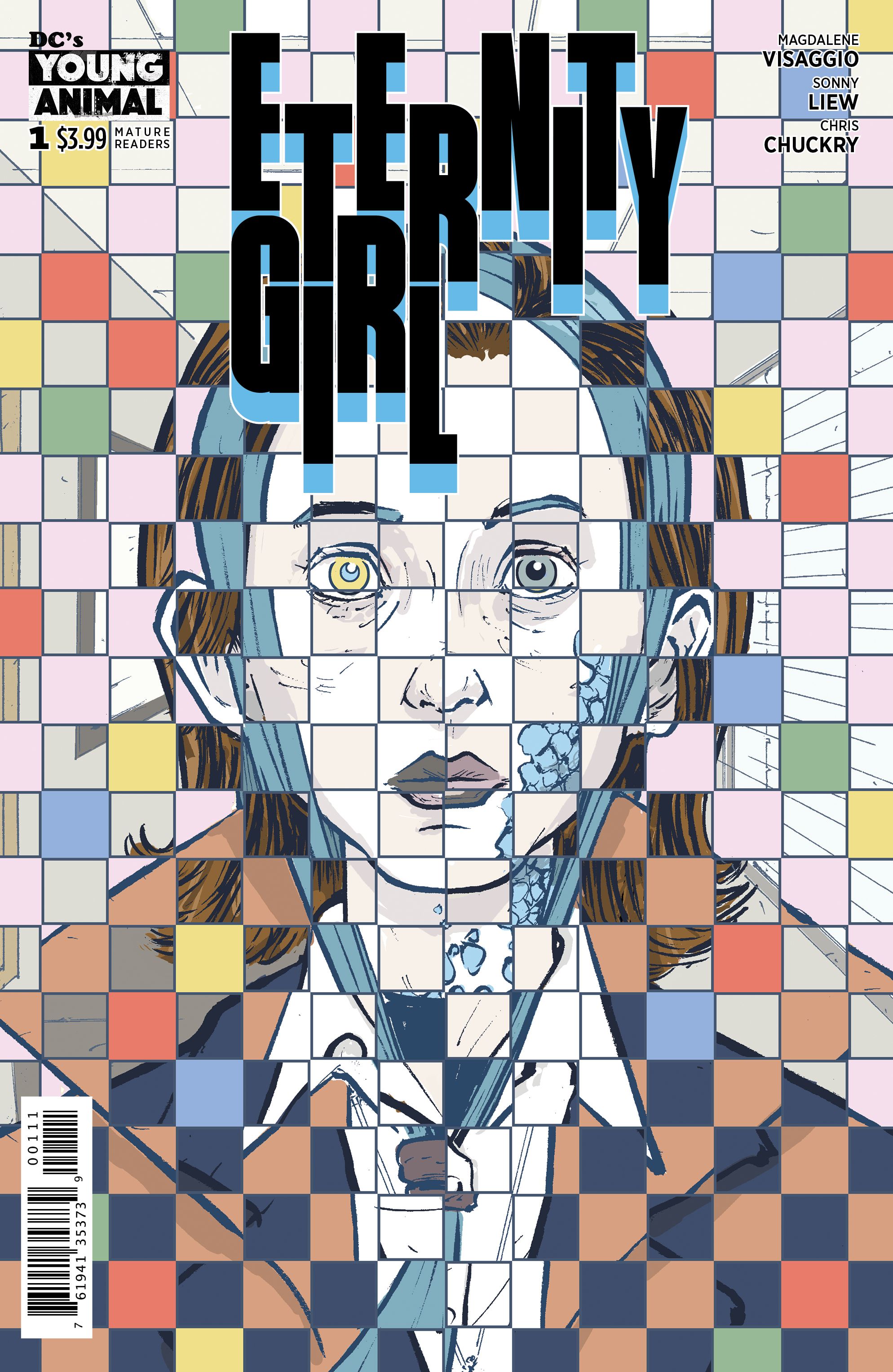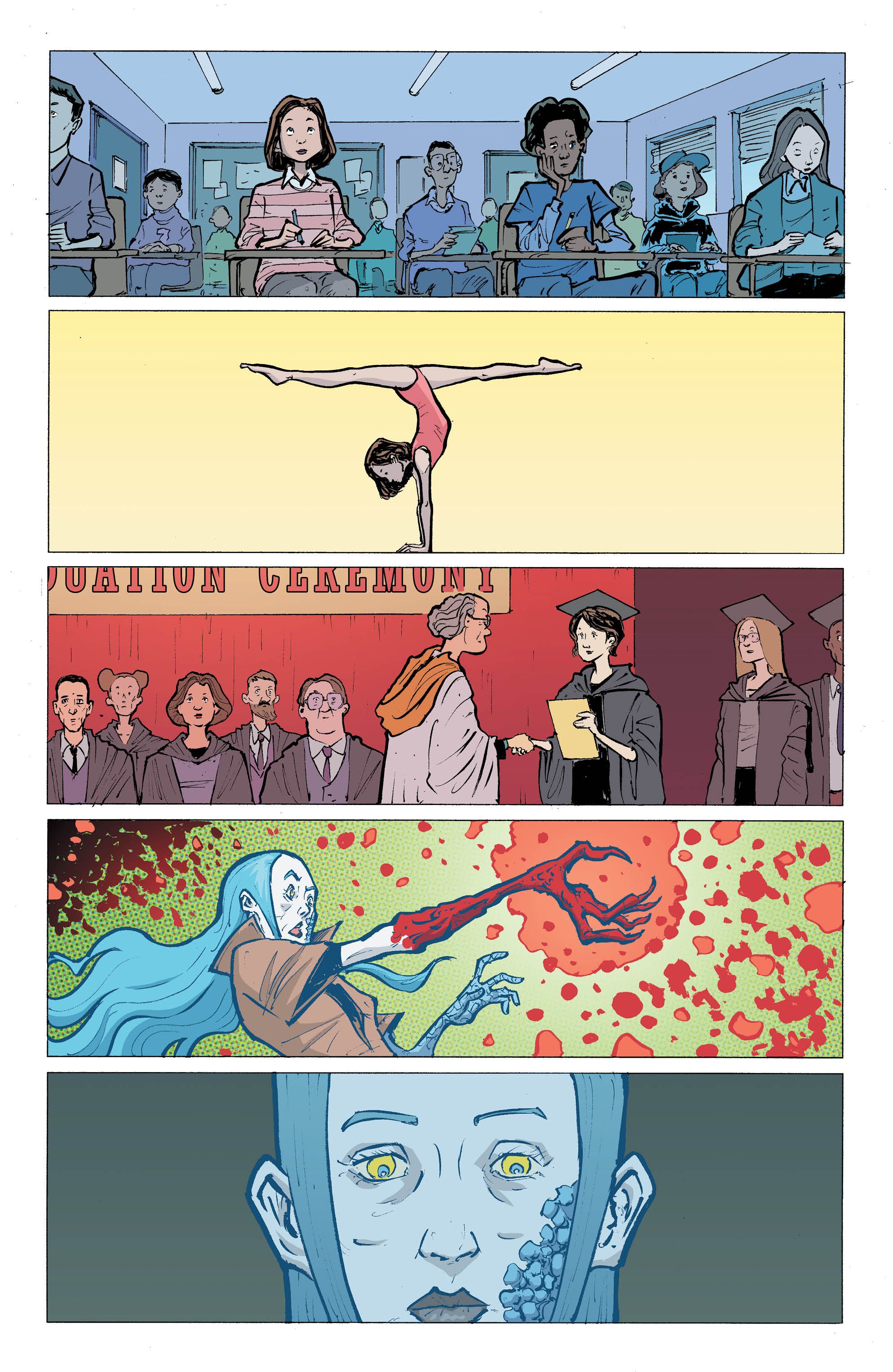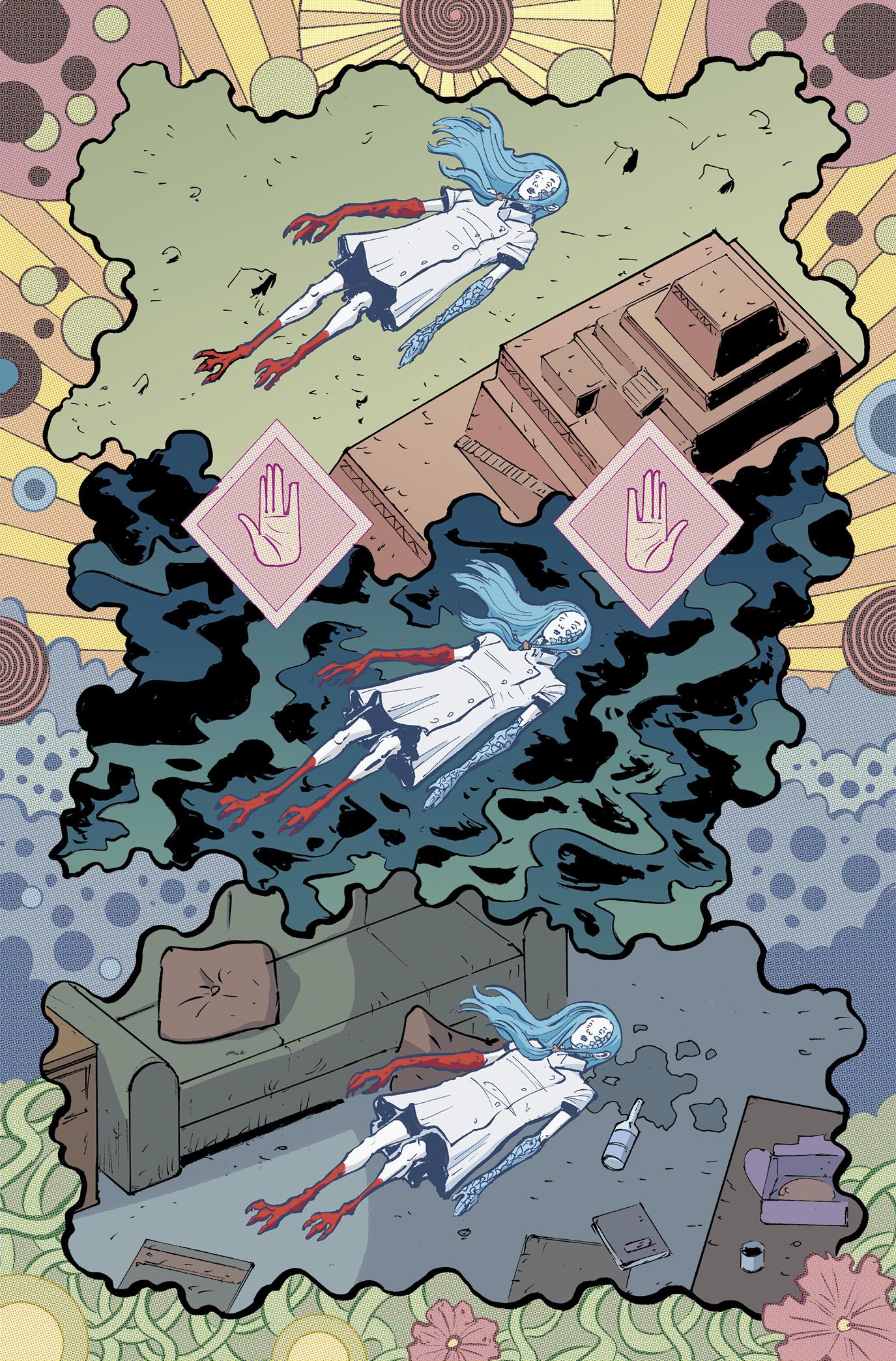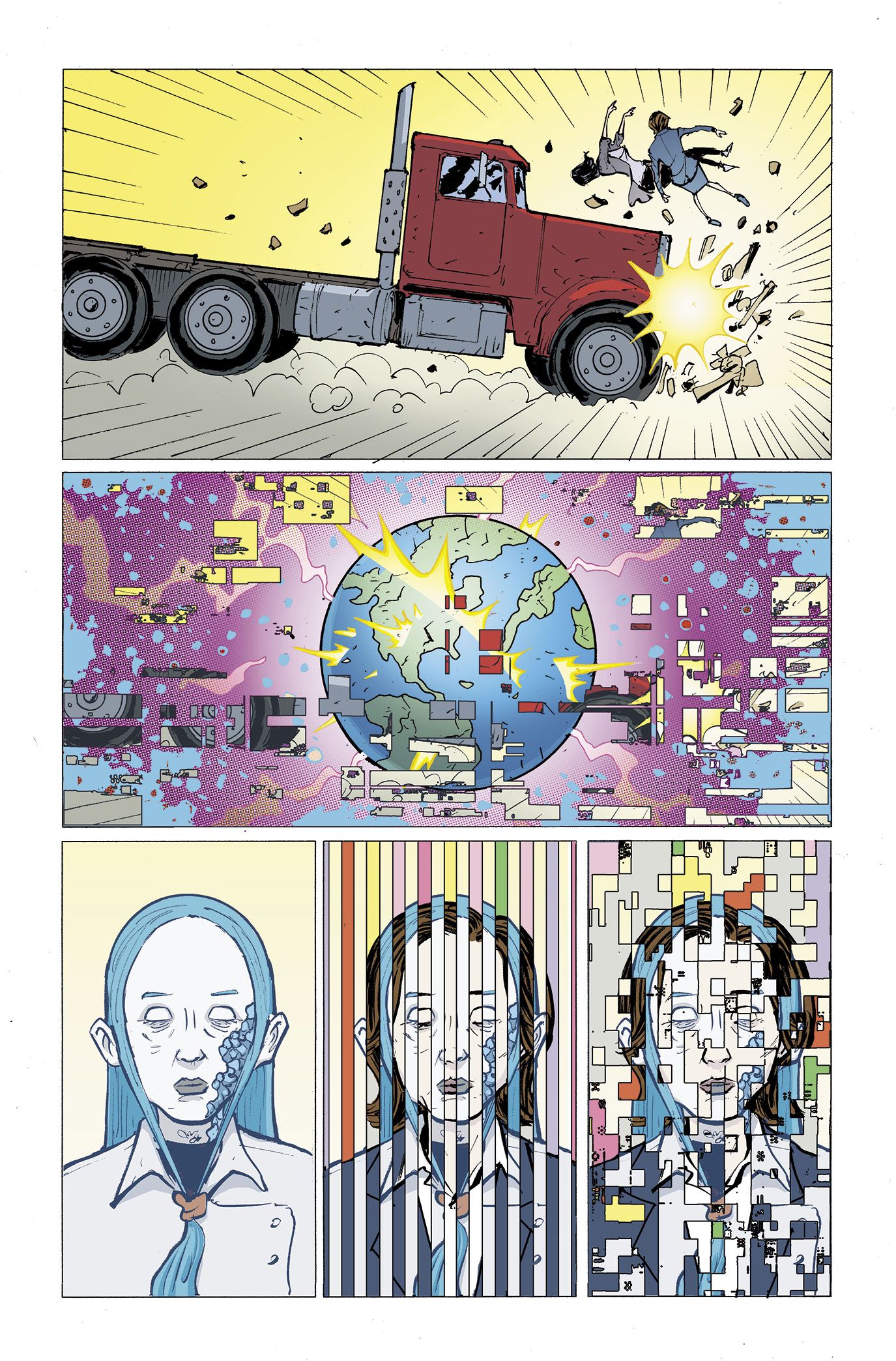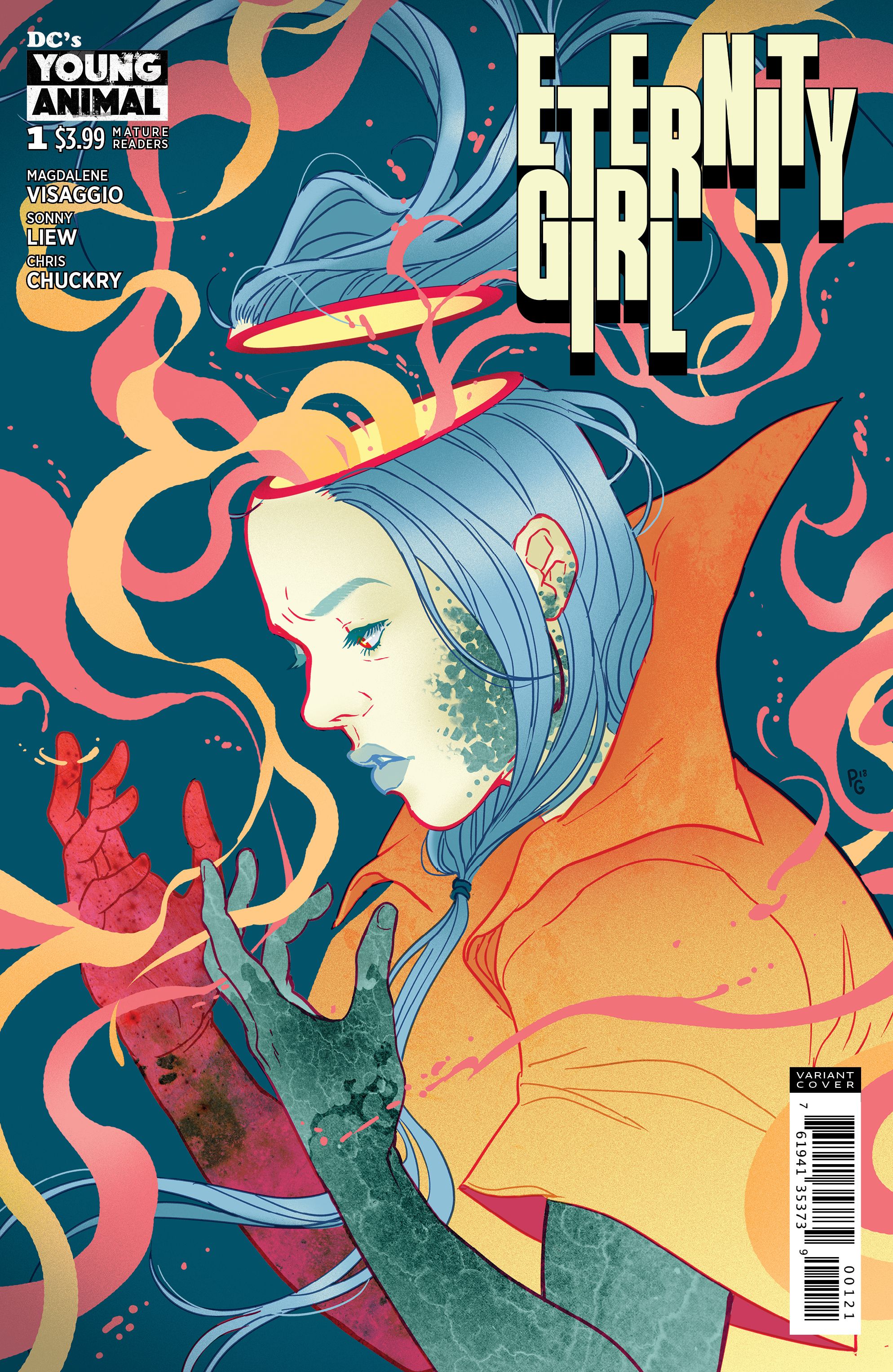Magdalene Visaggio and Sonny Liew make their Young Animal debut with Eternity Girl #1, out this week. The six-issue series from DC’s pop up imprint follows superpowered agent Caroline Sharp as she tries to get back on the roster at Alpha 13, after being benched following an "incident." Caroline is depressed and traumatized, and Eternity Girl doesn't hold back with either. It's a brutal, beautiful comic that uses superheroics and the super-body to explore dissociation, suicidal ideation and dysphoria.
While Caroline Sharp is new to the Young Animal universe, she feels like she's always been there, and here in the big cultural soup of superheroes and supernatural pop culture IPs. Comics are full of radical, involuntary bodily transformations and superpowers that hurt as much as they help. Caroline feels like a cousin to all these characters whose lives were transformed, both positively and tragically, by gaining powers -- but unlike many of them, she's in a comic that doesn't need to put hers on hold to get back to the action.
RELATED: DC’s Young Animal Imprint Gets Major Revamp in March
CBR talked to Visaggio, Liew and colorist Chris Chuckry about the development of Caroline Sharp and Eternity Girl.
CBR: The first thing that got me interested in Eternity Girl was that fantastic cover. Then I saw who was on the team! Mags, Sonny, tell me a bit about how the book and this team came together. And how did you find the experience of collaborating on it?
Magdalene Visaggio: The development process for this book has been really lengthy, going back to Thanksgiving 2016. But for all that, the book honestly hasn’t changed that much. Casting the artist on this book was probably the most difficult part of the process -- it’s such a weird, specific story, and the tone needed to be perfect.
At some point in the process I remembered how blown away I was by Sonny Liew’s work on Doctor Fate, which was the only place I really knew him from, and I threw his name into the hat. [Young Animal curator] Gerard [Way] and Jamie Rich, who was the editor on Eternity Girl all through the development process, both immediately fell in love with the idea. They knew his work better than me; they understood the immense breadth of his talent, his versatility. He’s been an absolute wonder to work with, and he elevates my writing while at the same time giving me the freedom to ask for things I don’t know I could have with anyone else.
Sonny Liew: I got an email from editor Jamie Rich asking if I'd be interested in working on a new title for DC Young Animal sometime last year -- in some ways it felt like a return to the roots of my first DC gig with Vertigo (My Faith in Frankie with Mike Carey and Marc Hempel). Mag's idea for a superheroine suffering from depression was fascinating, and I could envision introducing some slightly alternative comics art style elements to complement the narrative, so it all seemed like an interesting challenge to take on; sort of mainstream work with a real edge to it. We got to hang out a little bit at San Diego Comic-Con and have been working on getting the series done ever since.
As a result of a government experiment -- I think? -- Caroline Sharp, aka Chrysalis, has bird-like feet, clawed hands, yellow eyes and some grayscale-looking skin. It also gave her powers, which include shape-shifting, energy blasts and being “a wave function, an intrinsic field interacting with other intrinsic fields.” In short, as of this first issue we don’t know the full scope of her abilities and how the experiment affected her. Mags, what were your inspirations for the character, variously called a “sumerian elemental goddess” and a “foul-smelling homunculus”?
Visaggio: First, it wasn’t a government experiment. It was a mission deep into the Iraqi desert to stop a supervillain from unlocking this exact power.
There are two primary sources pouring into Caroline: one, obviously, is Element Girl, from whom we borrow the broad outlines of her origin (we went Babylonian instead of Egyptian) and the basic idea of her body configuration. The other is Doctor Manhattan, from whom I stole the concept of an intrinsic field and its weird properties over matter. The Manhattan influence is worth mentioning also, because, while it didn’t influence the course of her depression, it has strong resonances: the sense of disconnection and depersonalization I have found so characteristic of in my depression, I find echoes in the blue naked guy.
So, her powers aren’t identical to those of Doctor Manhattan or Element Girl, but borrow from both; she’s a shape-shifter who can transform herself into everything from a human to a big steel monolith to noxious gas, because she has utter control over her atomic structure because she is functionally identical with her own intrinsic field. That also lets her shoot charged electrostatic blasts.
That’s not all she can do, either, but that’s spoilers.
So for Caroline is that mission a source of trauma, or at least troubling memories, both for transforming her but also because it's a kind of successful failure? She succeeded at her mission, but not the way she was meant to?
Visaggio: Basically, the mission is something she resents, and it underlines the extent to which she feels used and helpless; everything she did, she did for Alpha 13, and it cost her her humanity, and then they tossed her out. She was always someone driven by duty, someone full of drive and energy who wanted to do great things, and the big disappointment of her life is that Alpha 13 just wrung every ounce of usefulness out of her. That's part of the trauma: her being abandoned.
There's definitely a lot going on regarding her complicated feelings about what happened and the relationship it placed her in with regard to her body, which didn't emerge out of the aether when she lost control of her powers. But I think that created a sense of alienation; that she's not even really in control of her body. Her relationship to it is severed. So the initial trauma regarding the transformation was something she could easily displace as long as it seemed to have meaning for her. When that meaning fell away, well, it was all downhill.
Page 2: [valnet-url-page page=2 paginated=0 text='Writing honestly about depression, inspirations for Eternity Girl and its striking color palette']
We’re seeing more and more superhero (and superhero adjacent) comics explicitly tackle mental health, but I think Eternity Girl manages a nice balance of matter-of-fact and weird. The comic doesn't play coy with Caroline Sharp’s struggles or her past, and her reluctant immortality adds an interesting new dimension: a character who wants to die but can’t. Why did you decide to tackle Caroline’s story, and what do you hope to achieve with it?
Visaggio: Depression is my life story, and I can pretty reasonably say I’ve suffered from it in one form or another since I was 10 or 11, with varying degrees of suicidality along the way. And I was pitching this book during one of my bleakest periods, as both my marriage and my job were falling apart, and both would be over three months after I sent it in. So depression and suicide were on my mind in a big way.
My first Young Animal work was doing a backup in Shade the Changing Girl starring Element Girl, who you may remember very famously commits suicide during Gaiman’s Sandman. Suicidality is sort of built into my own personal Young Animal shocking secret origin. So, based on how positively Shade editor Jamie Rich received that story, I decided to really work out my hustle and asked if I could pitch a book based on it. He was open to it, and I hashed out the basic outline of the story during a four-hour bus ride to visit my sister for Thanksgiving.
I love “Façade,” Gaiman’s Element Girl story, but I wanted to tackle suicide from an angle that didn’t focus on despair, but on recovery, because I’ve dealt with suicidal ideation for most of my life, and have had several near-misses. So that was my approach going in: be honest about what depression has felt like for me.
So I guess in a lot of ways this is depression from a super-specific angle: I'm trans and I'm autistic, so this is a depression fueled by body dysphoria and manifesting as depersonalization, de-realization and dissociation alongside the normal listless drifting, all of which fueled my suicidality. I had a constant feeling of not being real, like the world was sort of at a distance from me. That's something that's only receded since I transitioned.
The Eternity Girl interiors are an interesting mix of low-fi mundanity and bombastic, Silver Age sci-fi/fantasy. What were your inspirations for the book? Particularly, the extreme contrast between the everyday world and Caroline, her maybe-dissociations, her power and her self.
Liew: When I first read the story idea, more alternative comics creators like Charles Burns, Chester Brown and Daniel Clowes came to mind, particularly the latter. I guess in books like Ghost World and Ice Haven, in stories like Caricature, he captures a kind of ennui and anxiety that I thought might be incorporated into Eternity Girl. The general flatness of the compositions would also allow us to heighten the contrast with the sci-fi/fantasy scenes that are influenced by everyone from Jack Kirby to Wally Wood and Steve Ditko.
I suppose that's the old dictum of allowing yourself the room to move through different gears in a story; introduce different kinds of visual intensities as the narrative requires. Plus, I think Mags saw my interest in paying homage to older comic styles in The Art of Charlie Chan Hock Chye, so she's been asking for experimentations with different art styles in the book, as well as the early stingers that appeared as two-pagers in the Milk Wars titles. Hopefully we've not been too far off the mark in those!
Even when the comic is at its wildest (crashing trucks, explosions of power, weird dreams) the color palette is restrained. To me, it softens the blunt edges of the story while also evoking faded newsprint comics -- but maybe I’m completely wrong! What were you aiming for?
Liew: Well... my own preference has always been towards less saturated palettes, maybe more old school as well, back when comics were constrained by technology to a limited number of colors -- a constraint they turned into an advantage in many ways, developing a language of color that helped establish a certain look for comics that still resonate today. Sometimes more can be less, as they say.
A lot of the credit has to go to Chris Chuckry of course -- someone I remembered from his work on some of Seth Fisher's books, as well as The Flintstones series more recently. We had some discussions about the look of the book, and he's been able to bring the art to a whole different level, and I'm so very glad he agreed to come on board for this project.
Chris Chuckry: I developed this approach after getting input from Sonny. He had some specific ideas on how he would like the color to be handled, and I was happy to oblige. Specifically, he requested a restrained palette with simple rendering for the present day scenes, and an older, Golden and Silver-Age approach for the flashbacks -- complete with larger half-tone dots and added paper texture. Older comic books were colored with a more limited color palette than is available today, so I tried to keep true to that color style. That might account for the restrained color palette you're seeing -- or maybe it's a little of my restrained personality showing through.
RELATED: JLA/Young Animal: Milk Wars Details & Covers Revealed
While I know you can’t spoil the whole thing for me (sigh), what can tell me about where Caroline’s story is going after this first, pretty brutal issue?
Visaggio: Space. But not the space you’re thinking of. We’re really leaning into the Jack Kirby aesthetic going forward.
Liew: Visually the issues get wilder as the story progresses -- Mags is always throwing in things that I have no idea how to pull off, and it's always a dive into the unknown with every issue. I hope readers will stay tuned and come along for the ride, mixed metaphors and all.
Eternity Girl #1 is available March 14 from DC Comics.

